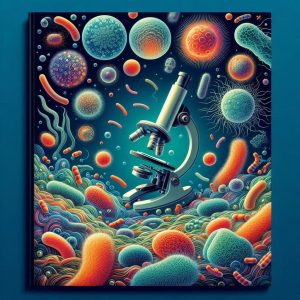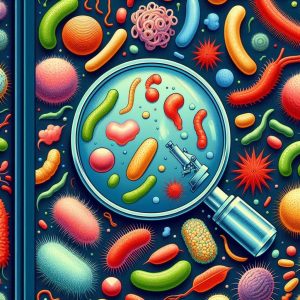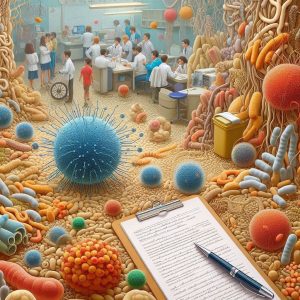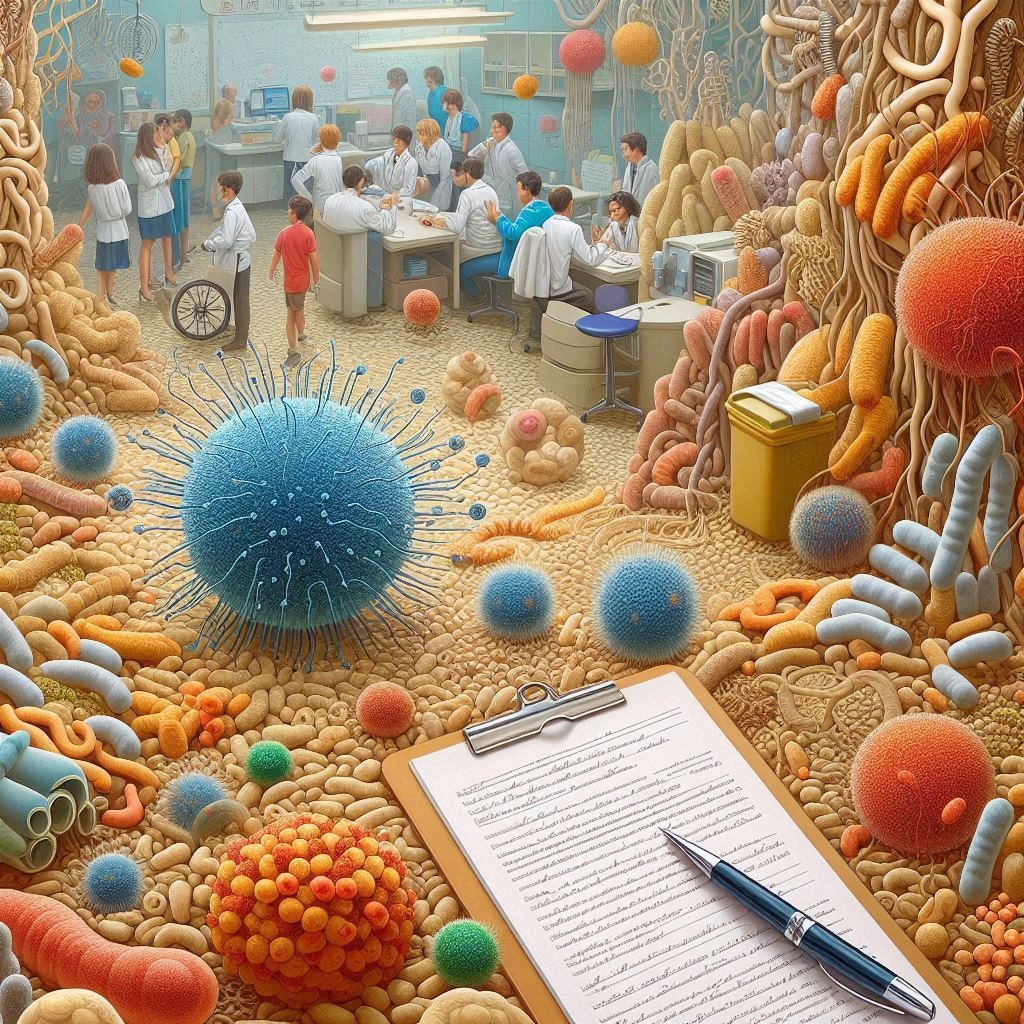Bacteria: The Microscopic Powerhouses
Bacteria, the microscopic single-celled organisms, are among the most abundant life forms on Earth. They thrive in diverse environments, from the deepest oceans to the human gut, playing essential roles in ecosystems, industry, and health. This article explores the nature of bacteria, their significance, and their applications.
The History of Bacteria
Bacteria, one of the oldest life forms on Earth, have a rich history that spans billions of years. From their origins in primordial oceans to their discovery and impact on human health, bacteria have played a pivotal role in shaping life as we know it. This article explores the fascinating history of bacteria.
Origins of Bacteria
Bacteria are among the first life forms to appear on Earth, dating back approximately 3.5 billion years. They likely originated in hydrothermal vents or shallow seas, where conditions were suitable for the formation of primitive life. For a detailed exploration of the origins of life, visit NCBI on the Origin of Life.
The Discovery of Bacteria
The existence of bacteria was first discovered in the 17th century by Dutch scientist Antonie van Leeuwenhoek, who is often called the “Father of Microbiology.” Using a simple microscope, he observed “animalcules” in water droplets, which were later identified as bacteria. Learn more about his groundbreaking work at Britannica on Antonie van Leeuwenhoek.

Advancements in Microbiology
The 19th century saw significant advancements in the study of bacteria. Louis Pasteur and Robert Koch made groundbreaking contributions to microbiology, establishing the germ theory of disease. Pasteur developed pasteurization, while Koch’s postulates provided a framework for linking specific bacteria to diseases. For more on these pioneers, visit Institut Pasteur and Khan Academy on Robert Koch.
The Era of Antibiotics
The discovery of antibiotics marked a turning point in the fight against bacterial infections. In 1928, Alexander Fleming discovered penicillin, the first true antibiotic, which revolutionized medicine. The development and widespread use of antibiotics have saved countless lives. For more on the history of antibiotics, see ACS on Penicillin.
Modern Bacteriology
The 20th and 21st centuries have seen incredible advancements in our understanding of bacteria. The development of molecular biology techniques, such as DNA sequencing, has allowed scientists to study bacterial genetics and evolution in unprecedented detail. The Human Microbiome Project, launched in 2007, has shed light on the complex interactions between bacteria and the human body. Learn more about modern bacteriology at The Human.
What Are Bacteria?
Bacteria are prokaryotic microorganisms that lack a membrane-bound nucleus. They come in various shapes, such as rods, spheres, and spirals, and reproduce through binary fission. To understand more about bacterial structure and classification, visit Microbiology Info.
Types of Bacteria
1. Gram-Positive Bacteria
Gram-positive bacteria have a thick peptidoglycan cell wall that retains the crystal violet stain used in Gram staining. Examples include Staphylococcus aureus and Corynebacterium diphtheriae.
2. Gram-Negative Bacteria
Gram-negative bacteria have a thin peptidoglycan layer and an outer membrane, which does not retain the crystal violet stain. They are often more resistant to antibiotics. Examples include Escherichia coli and Vibrio cholerae.
Ecological Roles of Bacteria
Bacteria are fundamental to ecosystem functioning. They participate in nutrient cycling, decomposition, and symbiotic relationships with other organisms. For a deeper understanding of bacterial roles in ecosystems, check out Nature Reviews Microbiology.

Bacteria in Human Health
1. Beneficial Bacteria
Beneficial bacteria, such as those found in the human gut microbiome, aid in digestion, nutrient absorption, and immune function. Probiotics, which are live beneficial bacteria, can promote gut health. For more information on probiotics, visit Mayo Clinic on Probiotics.
2. Pathogenic Bacteria
Pathogenic bacteria cause diseases such as tuberculosis, pneumonia, and food poisoning. Understanding how these bacteria operate is crucial for developing treatments and prevention strategies. Explore more about bacterial pathogens at WHO on Bacterial Infections.
Industrial Applications of Bacteria
Bacteria play a crucial role in various industrial processes due to their diverse metabolic capabilities and adaptability. These microorganisms have been harnessed to improve production efficiency, sustainability, and innovation across multiple sectors. Here, we delve deeper into the significant industrial applications of bacteria.
Biotechnology
1. Antibiotic Production
Bacteria, such as Streptomyces species, are prolific producers of antibiotics. These compounds are vital for treating bacterial infections. The discovery and development of antibiotics have revolutionized medicine, significantly reducing mortality rates. For an in-depth look at antibiotic production, visit NCBI on Antibiotic Production.
2. Enzyme Production
Enzymes produced by bacteria are used in numerous industrial processes, including food processing, textiles, and detergents. For example, Bacillus species produce amylases and proteases that are used to break down starches and proteins, respectively. Learn more about industrial enzymes at ScienceDirect on Industrial Enzymes.
3. Biofuel Production
Bacteria are employed in the production of biofuels, such as ethanol and biodiesel, from biomass. This process is known as microbial fermentation. Bacteria like Clostridium species can convert organic waste into biofuels, offering a renewable energy source. For more information on biofuel production, visit Frontiers in Microbiology on Biofuels.
Bioremediation
Bioremediation utilizes bacteria to clean up environmental contaminants, including oil spills, heavy metals, and pesticides. These bacteria metabolize pollutants, converting them into less harmful substances. Notable examples include Pseudomonas species, which can degrade hydrocarbons, and Geobacter species, which can reduce heavy metals. Explore more about bioremediation at ScienceDirect on Bioremediation.
Food Industry
1. Fermentation
Bacterial fermentation is crucial in the production of various foods and beverages, including yogurt, cheese, sauerkraut, and beer. Lactic acid bacteria, such as Lactobacillus species, are essential for fermenting dairy products. For insights into bacterial fermentation in the food industry, visit NCBI on Fermentation.
2. Probiotics
Probiotics are live beneficial bacteria added to foods to promote gut health. These bacteria can enhance digestion, boost immunity, and prevent harmful bacterial growth. Common probiotic bacteria include Bifidobacterium and Lactobacillus. For more on probiotics, visit Harvard Health on Probiotics.
Agriculture
1. Biofertilizers
Bacterial biofertilizers enhance soil fertility and plant growth by fixing atmospheric nitrogen, solubilizing phosphorus, and decomposing organic matter. Rhizobium species, for instance, form symbiotic relationships with legumes to fix nitrogen. To learn more about biofertilizers, visit ResearchGate on Biofertilizers.
2. Biopesticides
Bacterial biopesticides, such as Bacillus thuringiensis (Bt), produce toxins that are harmful to specific insect pests but safe for humans, animals, and beneficial insects. These biopesticides are an eco-friendly alternative to chemical pesticides. For more details, visit EPA on Biopesticides.
Waste Treatment
1. Wastewater Treatment
Bacteria play a crucial role in wastewater treatment by breaking down organic matter and pollutants, making the water safe for discharge or reuse. Activated sludge systems rely on bacterial communities to degrade waste. For more on wastewater treatment, visit NCBI on Wastewater Treatment.
2. Composting
Composting involves the microbial decomposition of organic waste into nutrient-rich compost. Bacteria like Thermophilic species thrive in high temperatures and accelerate the breakdown of organic materials. For more information on composting, visit EPA on Composting.
Medical Applications
1. Drug Delivery
Genetically engineered bacteria can be used as vectors for targeted drug delivery, particularly in cancer therapy. These bacteria can selectively deliver therapeutic agents to tumor sites. To explore more about bacterial drug delivery, visit Frontiers in Bioengineering.
2. Vaccine Development
Bacteria are utilized in the development of vaccines, either as live attenuated strains or as vectors to deliver antigens. For instance, Salmonella strains have been engineered to deliver vaccines against various infectious diseases.
Current Research and Future Directions
The study of bacteria is a rapidly evolving field with numerous ongoing research initiatives aimed at harnessing their full potential. Researchers are exploring innovative ways to utilize bacteria in various sectors, from medicine to environmental science. Here, we discuss some of the current research trends and future directions in bacterial applications.
1. Synthetic Biology
Synthetic biology involves redesigning organisms for useful purposes by engineering them to have new abilities. Researchers are creating synthetic bacterial strains capable of producing biofuels, pharmaceuticals, and other valuable chemicals. For an in-depth overview, visit Nature on Synthetic Biology.
2. CRISPR and Gene Editing
The CRISPR-Cas system, originally discovered in bacteria, is now a revolutionary tool for genetic engineering. Researchers are using CRISPR to edit bacterial genomes for improved industrial applications, such as enhanced production of biofuels and bioplastics. Learn more about CRISPR technology at Genome.gov on CRISPR.
3. Microbiome Studies
Understanding the human microbiome is a major research focus. Studies are investigating how bacterial communities in the human body affect health and disease. This research has potential applications in developing personalized medicine and probiotics. For more information, visit Nature on Microbiome Research.
4. Environmental Biotechnology
Environmental biotechnology research focuses on using bacteria to address ecological challenges. This includes the bioremediation of contaminated environments, wastewater treatment, and the development of sustainable agricultural practices. For insights into environmental biotechnology, visit Frontiers in Environmental Biotechnology.
5. Antimicrobial Resistance
The rise of antimicrobial resistance (AMR) is a significant global health threat. Researchers are investigating new antibacterial compounds and strategies to combat resistant bacteria. This includes the development of bacteriophages and antimicrobial peptides. For more on antimicrobial resistance, visit WHO on Antimicrobial Resistance.
6. Industrial Symbiosis
Industrial symbiosis involves the collaboration of different industries to use each other’s by-products as resources. Bacteria play a key role in this concept, where waste from one process can be used by bacteria to produce valuable products in another. For more information on industrial symbiosis, visit ScienceDirect on Industrial Symbiosis.
7. Bioinformatics and Systems Biology
Bioinformatics and systems biology are critical in understanding bacterial functions and interactions on a genomic scale. These fields leverage computational tools to model bacterial behavior and predict the outcomes of genetic modifications. For more on bioinformatics, visit NCBI on Bioinformatics.
8. Space Exploration
Bacteria are also being studied for their potential roles in space exploration. They could be used to produce food, recycle waste, and support life systems on long-term space missions. For insights into bacteria in space, visit Frontiers in Microbiology on Space Exploration.
Conclusion
Bacteria are indispensable to life on Earth, with roles spanning from environmental maintenance to human health and industrial applications. Understanding and harnessing their capabilities offers immense potential for scientific and technological advancements. To explore more about the fascinating world of bacteria, visit Microbe World.
Frequently Asked Questions About Bacteria

1. What are bacteria?
Bacteria are single-celled microorganisms that exist in various shapes and sizes. They are found in almost every environment on Earth, including soil, water, and inside the human body. For more information, visit NCBI on Bacteria.
2. Are all bacteria harmful?
No, not all bacteria are harmful. While some bacteria cause diseases, many are beneficial and play essential roles in processes like digestion, nitrogen fixation, and decomposing organic matter. Learn more at CDC on Bacteria.
3. How do bacteria reproduce?
Bacteria primarily reproduce through binary fission, a process where a single bacterial cell divides into two identical daughter cells. For a detailed explanation, visit NCBI on Bacterial Reproduction.
4. What roles do bacteria play in the human body?
Bacteria in the human body, particularly in the gut, help digest food, produce vitamins, and protect against harmful pathogens. These beneficial bacteria are part of the human microbiome. Read more at NIH on Gut Bacteria.
5. What is antibiotic resistance?
Antibiotic resistance occurs when bacteria evolve mechanisms to resist the effects of antibiotics. This makes infections harder to treat and can lead to more severe illnesses. For more details, visit WHO on Antibiotic Resistance.
6. How do bacteria benefit agriculture?
Bacteria benefit agriculture by fixing nitrogen, decomposing organic matter, and promoting plant growth. Biofertilizers and biopesticides are bacterial applications that improve soil fertility and pest control. Learn more at Frontiers in Plant Science on Bacteria in Agriculture.
7. What is the role of bacteria in the environment?
Bacteria play critical roles in the environment, including decomposing organic material, cycling nutrients, and breaking down pollutants through bioremediation. For more information, visit Nature on Environmental Bacteria.
8. How are bacteria used in biotechnology?
In biotechnology, bacteria are used to produce antibiotics, enzymes, biofuels, and other valuable products. Genetic engineering and synthetic biology further enhance their capabilities. Explore more at NCBI on Bacteria in Biotechnology.
9. What are extremophiles?
Extremophiles are bacteria that thrive in extreme environments, such as high temperatures, acidity, or salinity. These organisms are studied for their unique adaptations and potential industrial applications. For more on extremophiles, visit Nature on Extremophiles.
10. How do bacteria contribute to the food industry?
Bacteria are essential in the food industry for fermentation processes, producing yogurt, cheese, sauerkraut, and other fermented foods. Probiotic bacteria also promote gut health. Learn more at NCBI on Fermentation.
11. What is bioremediation?
Bioremediation is the process of using bacteria to degrade environmental pollutants and clean up contaminated sites. This technique is used for oil spills, heavy metals, and other pollutants. For more details, visit ScienceDirect on Bioremediation.
12. How are bacteria involved in biofuel production?
Bacteria are used to convert biomass into biofuels, such as ethanol and biodiesel, through fermentation processes. This renewable energy source reduces reliance on fossil fuels. For more on bacterial biofuels, visit Frontiers in Microbiology on Biofuels.
13. What is the significance of the human microbiome?
The human microbiome consists of the trillions of bacteria living in and on our bodies. It plays a crucial role in digestion, immunity, and overall health. Disruptions in the microbiome are linked to various diseases. For more on the human microbiome, visit NIH on Human Microbiome.
Disclaimers and Cautions
Understanding bacteria and their applications is essential, but it is crucial to be aware of certain disclaimers and cautions associated with bacterial research and utilization.
1. Safety Precautions in Laboratory Settings
When handling bacteria in a laboratory setting, it is vital to follow proper safety protocols to prevent contamination and exposure. Always use personal protective equipment (PPE), such as gloves and lab coats, and work in a controlled environment like a biosafety cabinet. For guidelines on laboratory safety, visit CDC Biosafety Guidelines.
2. Risks of Antibiotic Resistance
Excessive or inappropriate use of antibiotics can lead to the development of antibiotic-resistant bacteria, posing significant health risks. It is important to use antibiotics judiciously and follow prescribed treatments. For more information on antibiotic resistance, refer to WHO on Antimicrobial Resistance.
3. Environmental Impact of Biotechnological Applications
Biotechnological applications involving bacteria, such as bioremediation or biofuel production, must be managed carefully to avoid unintended ecological impacts. Ensure that such processes are well-regulated and monitored to prevent environmental harm. Learn more about these considerations at ScienceDirect on Environmental Impact.
4. Potential Health Risks of Probiotics
While probiotics can be beneficial, they may also pose risks for individuals with compromised immune systems or underlying health conditions. Consult healthcare providers before using probiotic supplements. For guidance on probiotics, visit NIH on Probiotics.
5. Ethical Considerations in Genetic Modification
The genetic modification of bacteria for research or industrial purposes raises ethical concerns, particularly regarding unintended consequences and ecological impacts. Ethical review boards and regulations should be followed to ensure responsible use. Learn more about ethics in genetic research at NCBI on Ethics in Genetic Modification.
6. Limitations of Bacterial Bioremediation
While bacterial bioremediation can effectively clean up pollutants, it may not be suitable for all types of contaminants or environments. It is important to assess the feasibility and efficiency of bioremediation technologies for specific cases. For more on limitations, visit ScienceDirect on Bioremediation Limitations.



